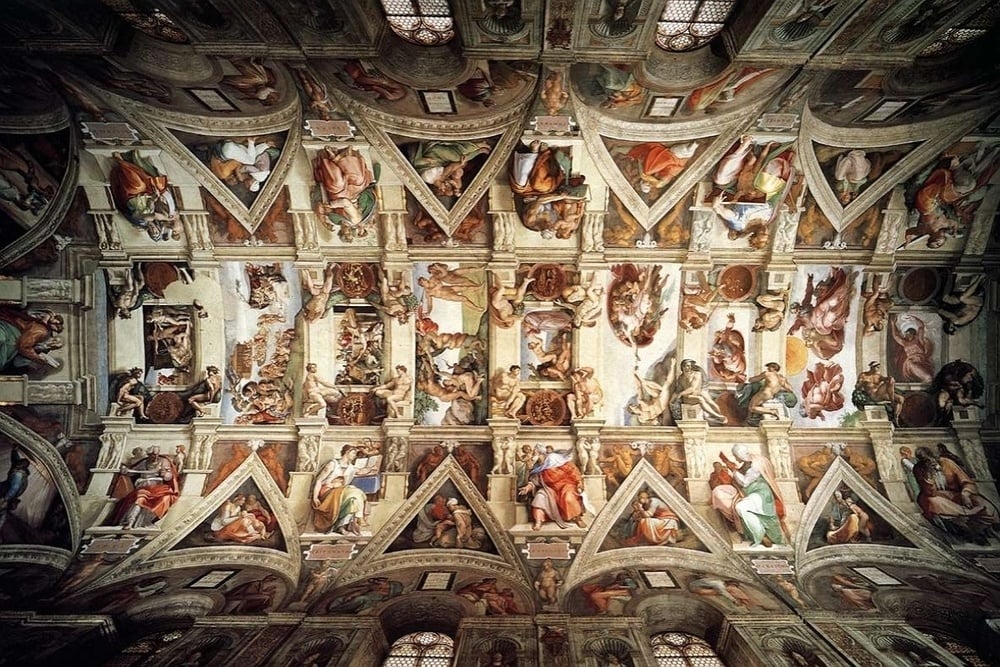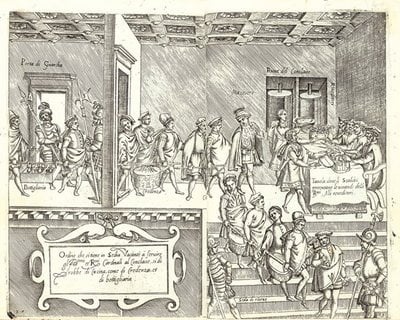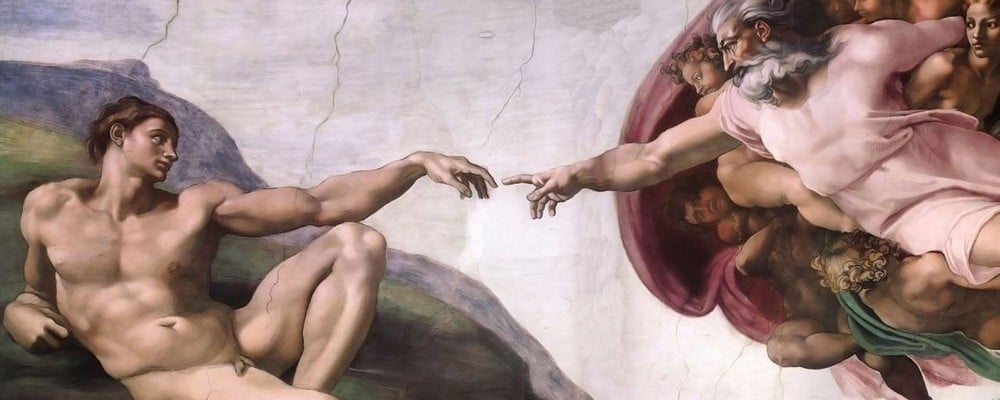
The Renaissance Papal Conclave: What Did They Eat?


The last month has been a month of massive tumult for the Catholic Church. For the first time in 400 years a Pope is resigning. There have only been five Popes to resign and all of them resigned under great duress, or in the case of Gregory XII, he did it to end the Western Schism. This is the first Pope to cite "health" problems as a reason to resign and the first to revise rules regarding the convening of the Papal conclave so that it can be convened sooner than in the past (usually they have to wait 15 days). I have a bunch of my own speculations about that, but there are a million other places that the woes of the Church can be debated.
I'm here to talk about the food, specifically the food of the Renaissance papal conclave. If the Cardinals were sealed off, how did they get their food?
The focus of my second novel is on Bartolomeo Scappi, who was the cuoco segreto to several Popes. It's because of him that we know what a Renaissance conclave was like; after all, he had to prepare the food for all of the voting Cardinals. Fortunately he wrote it all down in his massive cookbook, first published in 1570, called "The Opera of Bartolomeo Scappi." Opera in Italian essentially means "work" or "body of work."
What happens in a papal conclave?
When the Pope dies (or in Pope Benedict's case, resigns), and after the funeral and many ceremonies related to the death of that Pope, all the Cardinals file into the Sistine Chapel and the doors are barred behind them. An area adjoining the Chapel is turned into housing with individual cells for each Cardinal. There are a limited number of servants and officials allowed into the conclave, a number that has varied over the years. In modern times they also background check those individuals and sweep the Chapel for bugs so that the outside world does not know about the proceedings. The Cardinals debate and ponder and every day they cast a vote as to which Cardinal should become Pope. They stay in the conclave until a 2/3 vote is reached. Conclaves can take days, weeks, months or in some cases, even years.
In medieval times some restrictions were set to help push the process along.
"In an attempt to avoid future lengthy elections, Gregory X introduced stringent rules with the promulgation of Ubi periculum. Cardinals were to be secluded in a closed area and not accorded individual rooms. No cardinal was allowed, unless ill, to be attended by more than two servants. Food was supplied through a window to avoid outside contact. After three days of the conclave, the cardinals were to receive only one dish a day; after another five days, they were to receive just bread and water. During the conclave, no cardinal was to receive any ecclesiastical revenue."
By the time of Scappi these rules had mostly been abolished, probably because it resulted in hasty decisions.
So what happened in a Renaissance Papal conclave?
In his Opera, Scappi describes the papal conclave of Paul III. He tells us that 59 cells were prepared for the Cardinals (several left sick and died before the conclave was complete) and they began entrance into the conclave on November 29th, 1549. It lasted until February 7, 1550. Scappi tells us of the cells, that they were 16 1/2 square, that they were decorated with cushions, bed sheets, mattresses and pillows all the color purple. They had a chamber pot, two stools a table, and other necessities, all decorated with purple. They also had a hamper, which Scappi describes in detail, for the transport of their food by servants from the kitchen to the cells (p.622). Everything was decorated with the Cardinal's specific coat of arms.
Each day the Cardinals were chosen by lot as to who would be served their food first. Scappi gives us more details:
The Lord Stewards, as I said, had a hamper for the kitchen food and a tub for the
credenza food, and they served that way. To begin with, each Steward had, in those
two containers, carefully prepared and arranged every item of food — the normal
credenza having been carried out by the Assayer, Cook, CeIlarer, Charcutier and
others who might have been involved in the handling of the food. His Mace Bearer
with his Most Reverend master’s Mace would lead off, followed by two Footmen
with two staves painted the same colour as the hamper. Then came the Steward with
four or six squires who bore carafes full of all sorts of wine and pure water; among
them walked the Cellarer carrying a small carafe of wine; the carafes were all
covered with oranges or flowers, and had labels on which the variety and quality of
the wines were written. Then came two Footmen bearing the large tub with the
Credenza foods. Then there followed the Assayers with two other Footmen
carrying the hamper. After them and accompanying the prepared dishes came a few
nobles, too, of that Most Reverend Cardinal. When the Steward was sent, as was
said, to the place where things were served up, he finds at the first grille the guard of
the Lord Magistrates; right by the end of the two staircases, he finds the italian
guards and the Swiss Guards; he goes along the corridor where there is another grille
with two gateways, one to enter by for serving, the other to come out by after having
served. As he goes in through that grille there is another Italian guard and Swiss
Guard who open and close; here the two Messengers (as I have said) who,
following the order on the list, summon the Stewards. Just past the grille there is a
table fifteen hands long and about four hands deep. When the Steward reaches it he
takes a very white napkin from the Assayer; in front of the aforementioned four
Bishops another napkin is spread out with two knives and a fork which those
Reverend Prelates would take, and he immediately presents himself along with the
squires, handing over the carafes of wine and water and removing from his tub the
several sorts of salad, fruit and other things needed for [f. A4r]
Scappi goes on to say that closed pies, whole chickens and other similar dishes were not allowed (too easy to include secret missives and bribes on how to vote). All food was thoroughly checked by special officials within the conclave. Wine was only allowed in open glasses, not closed vessels. When food was leftover it was distributed among the servants within.
Scappi also tells us about the changing of the guard, which Cardinals fell ill and left the conclave and other assorted details. There is even a plate within the book that shows what the hampers looked like!
What did Renaissance Cardinals eat when locked in a Papal conclave?
He doesn't tell us exactly what he served them, but we can guess based on the recipes he left within the Opera.
The Cardinals may have had pasta, including ravioli and rabbit parpadelle (stay tuned on the blog for this recipe in coming weeks!). Those hampers may have been carefully packed with cheesy breads, veal croquettes, roasted bear, grilled beef ribs, open faced mushroom crostatas, pheasant in red-currant sauce, and maybe even caviar omelets (made with cinnamon, sugar, orange juice and pepper). Eels cooked in wine, fried anchovies and razor clams, roasted broccoli, stuffed eggs and chickpea fritters may also have filled the Cardinal's bellies. Scappi even had recipes for early Neapolitan pizza, which were sweet, made of almonds, raisins, dates, figs, eggs and rosewater cooked on a flat, flaky pastry round. It was served hot or cold, just like pizza is enjoyed today. A variety of cold dishes were packed in the hampers since the hamper could only go into the conclave once a day.
The end of the conclave
The end of a conclave today is likely very similar to the way it ended in Scappi's time. After all the votes on each day, smoke is released from a chimney in the conclave. If the smoke is dark (made by throwing damp straw into the flames), then a new Pope has not been chosen. White smoke, however, signals that there is a new Pope.
At the end of the Conclave that Scappi describes that, at ten o'clock in the evening of November 29, 1549, the white smoke was released, announcing the choice of a new Pope, Giovanni del Monte, who chose to go by the name of Julius III.
I wonder if the Cardinals who convene on March 11th will be eating as well as those who chose Pope Julius did.
Related articles
- As pope departs, still no timescale for 'contentious' conclave (worldnews.nbcnews.com)
- Papal resignation, papal election (ddc.typepad.com)
- What Happens During a Papal Conclave? (patheos.com)
- How to Choose a New Pope (live.wsj.com)
- O'Malley heads to Rome for papal conclave (boston.com)
- O'Brien will no longer take part in papal conclave (itv.com)
- Thousands Watch Pope Fly Into Sunset (huffingtonpost.com)


